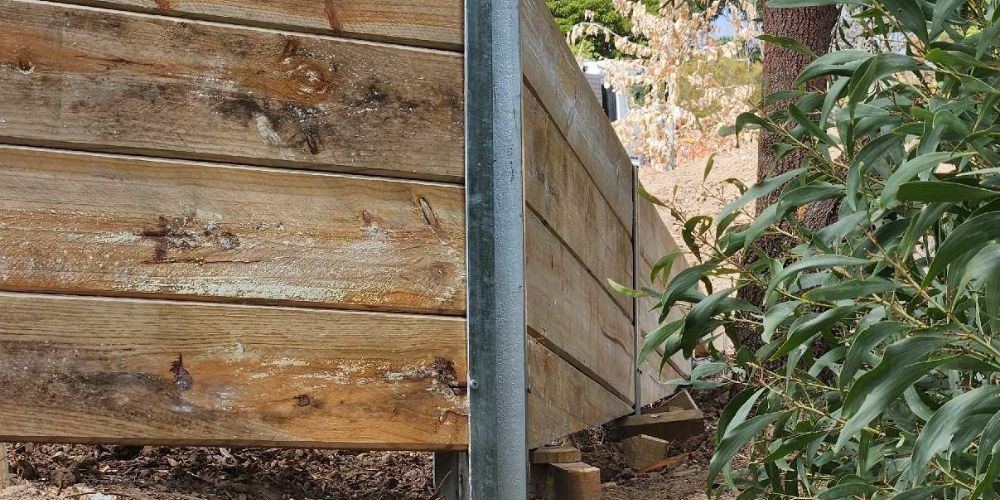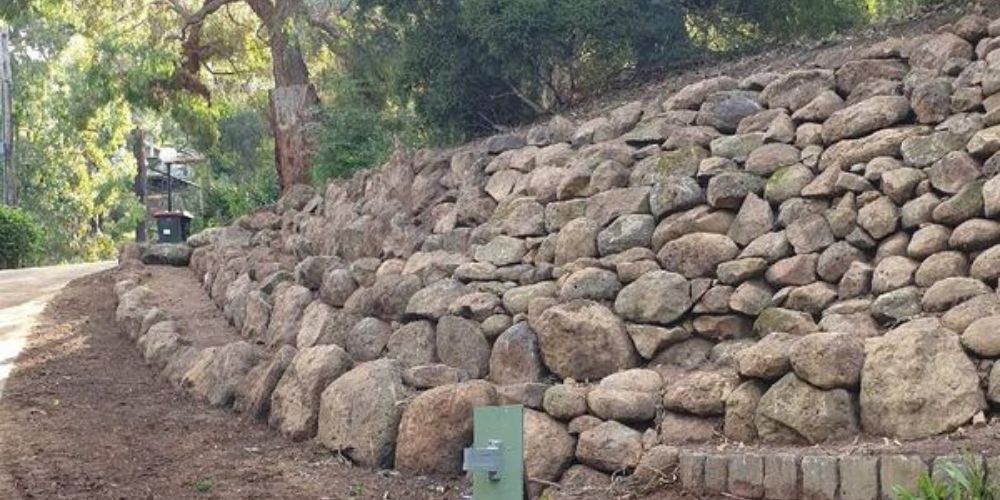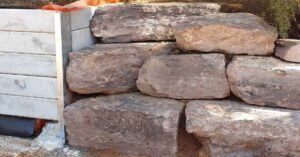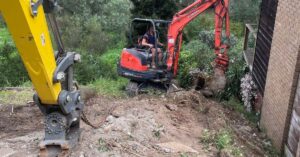Building on a Budget: Best Cheapest Retaining Wall Ideas
Retaining walls are a great way to manage slopes, prevent soil erosion, and add visually pleasing elements to your outdoor space. They not only serve a useful purpose but also provide limitless design opportunities. As a seasoned retaining wall builder in Melbourne, I can say that building a retaining wall might be relatively inexpensive at times.
But don’t worry! We’re here to show you that while building on a budget, you aren’t required to sacrifice beauty or quality. Whether you’re a seasoned DIY enthusiast or a beginner seeking simple yet effective ideas, we’ve got you covered.
Let’s get started and find the best and cheapest retaining wall ideas to make your landscaping visions a reality!

Affordable Retaining Wall Options
Several low-cost choices may still provide stunning effects when constructing a retaining wall on a budget. Let’s look at some ideas to help you build a beautiful and practical retaining wall without breaking the budget.
Concrete Blocks
Concrete blocks are a low-cost option for constructing a retaining wall. They are strong, long-lasting, and come in various sizes and forms to meet your design tastes. Concrete block walls may provide outstanding structural integrity while keeping prices low when properly installed.
Railroad Ties
Railroad ties, often built of wood or concrete, can be a low-cost choice for a rustic or industrial effect. These materials are easily accessible and may be piled or fixed into the earth to form a strong retaining wall. If you use wooden bindings, be sure they are in good shape and devoid of dangerous substances.
Gabion Walls
Gabions are wire mesh baskets that contain pebbles or stones. They offer a cost-effective yet visually appealing option for retaining walls. Gabion walls are quite simple to build and need little materials. They have great drainage and can mix nicely with the natural environment.
Timber Sleepers
Timber sleepers, typically composed of treated wood, are cost-effective for retaining walls. They are adaptable, simple to use, and may be mounted vertically or horizontally. Timber sleepers have a warm and natural appearance, making them a popular choice for conventional and modern designs.
Retaining Wall Kits
Consider using retaining wall kits if you want a simple and cost-effective option. These kits include pre-designed blocks or panels that readily fit together, reducing the need for specialised construction abilities. They provide a variety of design alternatives while keeping the total cost low.
Natural Stone
While some real stones might be costly, less expensive substitutes are available. Look for locally sourced stones or repurposed materials, which are generally less expensive. Natural stone walls give beauty and richness to your environment while being ageless and organic.
Terraced Gardens
Consider terracing your garden instead of building a standard retaining wall. Use the natural slope of your property and reduce the need for substantial construction by establishing many levels or layers. Terraced gardens give aesthetic beauty and functional areas for planting or sitting.
Pallets
Pallets can be one on the top of the list for low-cost retaining walls. Not only are they widely accessible, but they are frequently free! Look in your local classifieds for those giving them out for free or cheaply.
Once you have the pallets, get creative with your retaining wall. Fill the boards’ tops and vacant places with flowers. To save some space, try your hand at vertical gardening!
Poured Concrete
Pouring a solid concrete wall produces the strongest retaining wall but is also among the most costly. Excavation and labour account for more than half of the cost of a poured concrete retaining wall. Therefore bigger barriers can be pricey. Poured concrete walls can also be reinforced with rebar or other structural steel, allowing them to be built to any height.

Factors Affecting Retaining Wall Costs
Several elements come into play when determining the cost of a retaining wall. Understanding these factors will allow you to manage your budget more precisely. Here are some important factors that might influence the cost of a retaining wall:
- Materials: The materials used, such as concrete blocks, natural stone, or timber sleepers, can significantly influence the cost.
- Height and Length of the Wall: Taller walls or longer spans need more materials and, in certain cases, more reinforcing, raising the overall cost.
- Site Requirements: Site characteristics such as soil type, slope angle, and groundwater levels can all impact excavation and foundation needs, raising expenses.
- Design Difficulty: Customised designs, elaborate patterns, or integrated features such as stairs or seating spaces can increase labour and material costs.
- Labour Costs: The labour cost for building the retaining wall should be budgeted depending on the project’s intricacy and local salaries.
Cost-Saving Tips for Retaining Walls
There are various cost-cutting techniques for creating a retaining wall that can help you remain within your budget without sacrificing quality. Consider the following excellent suggestions:
Select Low-Cost Materials
Choose materials that are less expensive while yet provide durability and aesthetic appeal. Concrete blocks, timber sleepers, or locally produced natural stone might be less expensive than high-end materials.
DIY or Partial DIY
Consider doing part of the building yourself or with the assistance of friends and family. This can reduce labour expenses, particularly for simpler designs. However, carefully analyse your ability level and consult with specialists for more difficult undertakings.
Proper Design and Planning
To save extra costs, spend time planning and building your retaining wall. A well-thought-out design will save material waste, guarantee appropriate drainage, and limit the need for future costly adjustments.
Use Recycled or Reclaimed Materials
Consider using recycled or repurposed materials for your retaining wall. One example is repurposing old concrete blocks, railway sleepers, or recovered stones. This not only benefits the environment, but it may also drastically decrease expenditures.
Consider Terracing or Stepped Designs
Consider terracing or creating stepped forms instead of constructing a towering, single retaining wall. This method can assist in reducing the quantity of material required while also adding aesthetic appeal to your environment.
DIY Drainage Solutions
A strong and long-lasting retaining wall requires proper drainage. Consider DIY drainage alternatives such as inserting gravel or perforated pipes beneath the wall to avoid needing pricey professional drainage systems.
Improve Site Preparation
The lifetime of your retaining wall is dependent on proper site preparation. Before beginning construction, ensure that the land has been adequately dug and levelled and that any drainage difficulties have been addressed. You can avoid costly difficulties by addressing these issues early on.
Obtain Several Quotes
Compare pricing and services by obtaining quotations from several contractors or vendors. This will assist you in identifying cost-effective choices without sacrificing quality. Remember to consider warranties, experience, and customer reviews when selecting.
Frequently Asked Questions
Yes, retaining walls are frequently constructed on slopes to create level surfaces or to avoid soil erosion. Additional slope stability and drainage considerations may be required during the design and construction.
Retaining walls may be used to prevent soil erosion, manage slopes, create terraced areas, and give visual value to your environment. They give structural support and aid in the prevention of property damage.
Yes, there are various environmentally friendly retaining wall solutions. Recycling or recovering resources, such as reused concrete or rescued stones, may benefit the environment. Furthermore, adding suitable drainage and erosion control methods can assist in reducing the retaining wall’s environmental effect.
The height of your retaining wall should be decided by the demands of your project and the site circumstances. The height requirements will be influenced by soil type, slope angle, and the amount of soil to be preserved. Consultation with specialists or engineers may assist in ensuring that the wall is constructed to the proper height for stability.
Conclusion
A well-designed and well-built retaining wall may give your outdoor space the stability and aesthetic appeal it needs, whether managing soil erosion, coping with a sloping yard or constructing terraced spaces. You may effectively construct a cost-effective retaining wall that fits your demands and improves the appearance and functioning of your property for years to come with careful planning, budgeting, and consideration of all pertinent elements.
Ready to begin constructing your reasonably priced retaining wall? Use these cost-effective suggestions, seek the advice of experts, and set out on your quest to improve your landscape on a tight budget. Refrain from allowing the expense to stand in the way of your aspirations for outdoor design. Get ideas, make a thorough plan, and construct a beautiful, useful retaining wall that meets your requirements and increases the value of your property. Regardless where you are in Melbourne, you might be want to have retaining wall in Northcote, or in need of retaining wall installers in Clifton Hill, make the first move now to bring that vision to reality!

Share on facebook Facebook Share on twitter Twitter Share on linkedin LinkedIn Share on whatsapp WhatsApp Table of Contents If you’ve been thinking about building a retaining wall, one of the biggest questions you might face is whether to go with a boulder wall or a rock wall. Each option has its strengths, and choosing

Share on facebook Facebook Share on twitter Twitter Share on linkedin LinkedIn Share on whatsapp WhatsApp Table of Contents When starting a construction or landscaping project, one of the first questions people ask is, “How long will it take?” Excavation is a critical first step in many projects, setting the foundation (literally) for everything that

Share on facebook Facebook Share on twitter Twitter Share on linkedin LinkedIn Share on whatsapp WhatsApp Table of Contents When you think about excavation, you probably imagine a well-planned project where the site is prepared, utilities are marked, and every detail is carefully mapped out. But not all excavations have the luxury of time. Sometimes,
